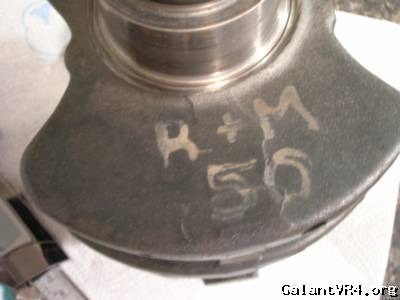Quoting holeshotmoe:
Confirmed it's stock...measured 44 mm main center to rod center.
*mains are all about 56.52 mm...the manual specs list 56.68 - 57 mm
*rod journals are all about 44.52...spec dimensions are 44.98 - 45 mm
I was wondering if it has been turned, perhaps resulting in the nitriding being removed and weakening it. It doesn't seem like there is much material missing from the specs, but I don't know what might be typical of normal wear vs commonly removed by machining. It had a stock crank pulley and flywheel. I did notice another marking on the piece as seen below

But again, I would like to know if one can tell from the castings what engine it originated. I'm asking because I found on the web different part numbers for several 2L turbo motors.
In this picture the crankshaft guy at the machine shop has noted that both the rods and mains have been undercut by .50 mm. This type of marking is fairly common among rebuilders, although there are variations. My crankshaft had RODS - Std written above MAINS - Std on a counterweight just like yours. Std = standard size, as was mentioned above.
On cranks that are nitrided, the process is only effective on the the first .020" to .025". That means that by having a .50 mm undercut, the machine shop has removed that nitriding completely, or left only a few thousands of an inch. This is likely the reason that your crank broke.